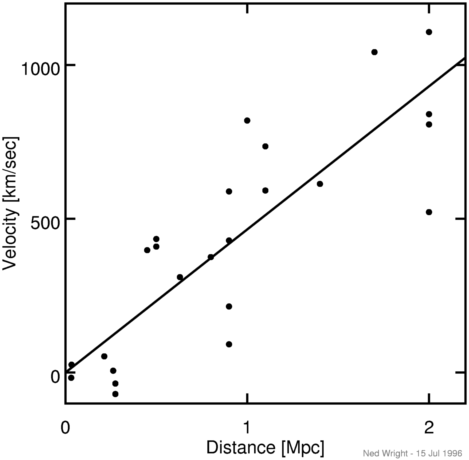
Until a few hundred years ago, the Solar System and the Universe were equivalent in the minds of scientists, so the discovery that the Earth is not the center of the Solar System was an important step in the development of cosmology. Early in the 20th century Shapley established that the Solar System is far from the center of the Milky Way. So by the 1920's, the stage was set for the critical observational discoveries that led to the Big Bang model of the Universe.

1/Ho = (978 Gyr)/(Ho in km/sec/Mpc)Thus Hubble's value is equivalent to approximately 2 Gyr. Since this should be close to the age of the Universe, and we know (and it was known in 1929) that the age of the Earth is larger than 2 billion years, Hubble's value for Ho led to considerable skepticism about cosmological models, and motivated the Steady State model. However, later work found that Hubble had confused two different kinds of Cepheid variable stars used for calibrating distances, and also that what Hubble thought were bright stars in distant galaxies were actually H II regions. Correcting for these errors has led to a lowering of the value of the Hubble constant: there are now primarily two groups using Cepheids: the HST Distance Scale Key Project team (Freedman, Kennicutt, Mould etal) which gets 72+/-8 km/sec/Mpc, while the Sandage team, also using HST observations of Cepheids to calibrate Type Ia supernovae, gets 57+/-4 km/sec/Mpc. Other methods to determine the distance scale include the time delay in gravitational lenses and the Sunyaev-Zeldovich effect in distant clusters: both are independent of the Cepheid calibration and give values consistent with the average of the two HST groups: 65+/-8 km/sec/Mpc. These results are consistent with a combination of results from CMB anisotropy and the accelerating expansion of the Universe which give 71+/-3.5 km/sec/Mpc. With this value for Ho, the "age" 1/Ho is 14 Gyr while the actual age from the consistent model is 13.7+/-0.2 Gyr.
Hubble's data in 1929 is actually quite poor, since individual
galaxies have peculiar velocities of several hundred km/sec,
and Hubble's data only went out to 1200 km/sec. This has led
some people to propose
quadratic redshift-distance laws,
but the data shown below on Type Ia SNe from
Riess, Press and Kirshner (1996)
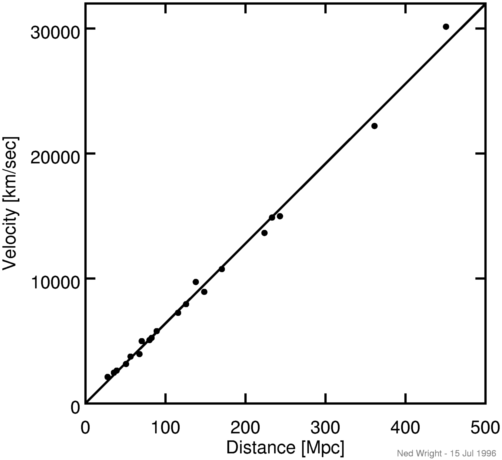
v = dD/dt = H*DThe fitted line in this graph has a slope of 64 km/sec/Mpc. Since we measure the radial velocity using the Doppler shift, it is often called the redshift. The redshift z is defined such that:
1 + z = lambda(observed)/lambda(emitted)where lambda is the wavelength of a line or feature in the spectrum of an object. We know from relativity that the redshift is given by
1 + z = sqrt((1+v/c)/(1-v/c)) so v = cz + ...
The subscript "o" in Ho (pronounced "aitch naught") indicates the current value of a time variable quantity. Since the 1/Ho is approximately the age of the Universe, the value of H depends on time. Another quantity with a naught is to, the age of the Universe.
The linear distance-redshift law found by Hubble is compatible with
a Copernican view of the Universe: our position is not a special one.
First note that the recession velocity is symmetric: if A sees B receding,
then B sees that A is receding, as shown in this diagram:



The Hubble law generates a homologous expansion which does not change the shapes of objects, while other possible velocity-distance relations lead to distortions during expansion.
The Hubble law defines a special frame of reference at any point in the Universe. An observer with a large motion with respect to the Hubble flow would measure blueshifts in front and large redshifts behind, instead of the same redshifts proportional to distance in all directions. Thus we can measure our motion relative to the Hubble flow, which is also our motion relative to the observable Universe. A comoving observer is at rest in this special frame of reference. Our Solar System is not quite comoving: we have a velocity of 370 km/sec relative to the observable Universe. The Local Group of galaxies, which includes the Milky Way, appears to be moving at 600 km/sec relative to the observable Universe.
Hubble also measured the number of galaxies in different directions
and at different brightness in the sky. He found approximately
the same number of faint galaxies in all directions, even though
there is a large excess of bright galaxies in the Northern part of
the sky. When a distribution is the same in all directions,
it is isotropic.
And when he looked for galaxies with fluxes brighter
than F/4 he saw approximately 8 times more galaxies than he
counted which were brighter than F. Since a flux 4 times smaller
implies a doubled distance, and hence a detection volume that
is 8 times larger, this indicated that the Universe is close
to homogeneous (having uniform density) on large scales.

Of course the Universe is not really homogeneous and isotropic,
because it contains dense regions like the Earth. But it can still
be statistically homogeneous and isotropic, like this
24 kB simulated galaxy field, which is
homogeneous and isotropic after smoothing out small scale details.
Peacock and Dodds (1994, MNRAS, 267, 1020) have looked at the
fractional density fluctuations in the nearby Universe as a function of
the radius of a top-hat smoothing filter, and find:
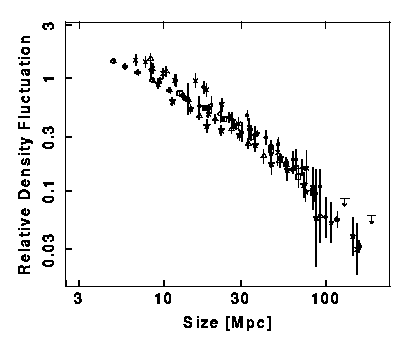
The case for an isotropic and homogeneous Universe became much stronger
after Penzias and Wilson announced the discovery of the Cosmic Microwave
Background in 1965. They observed an excess flux at 7.5 cm wavelength
equivalent to the radiation from a blackbody with a temperature of
3.7+/-1 degrees Kelvin. [The Kelvin temperature scale has degrees of the
same size as the Celsius scale, but it is referenced at absolute zero,
so the freezing point of water is 273.15 K.]
A blackbody radiator is an object that absorbs any radiation that hits it,
and has a constant temperature.
Many groups have measured
the intensity of the CMB at different wavelengths. Currently the best
information on the spectrum of the CMB comes from the FIRAS instrument
on the
COBE
satellite, and it is shown below:

The temperature of the CMB is almost the same all over the sky.
The figure below shows a map of the temperature on a scale where
0 K is black and 3 K is white.
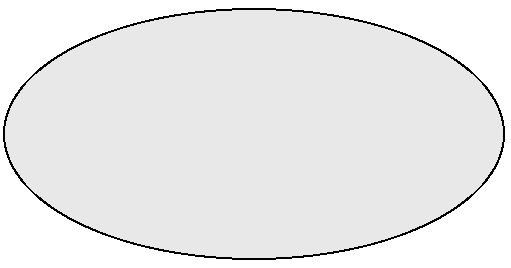
Another piece of evidence in favor of the Big Bang is the abundance of the light elements, like hydrogen, deuterium (heavy hydrogen), helium and lithium. As the Universe expands, the photons of the CMB lose energy due to the redshift and the CMB becomes cooler. That means that the CMB temperature was higher in the past. When the Universe was only a few minutes old, the temperature was high enough to make the light elements by nuclear fusion. The theory of Big Bang Nucleosynthesis predicts that about 1/4 of the mass of the Universe should be helium, which is very close to what is observed. The abundance of deuterium is inversely related to the density of nucleons in the Universe, and the observed value of the deuterium abundance suggests that there is one nucleon for every 4 cubic meters of space in the the Universe.
The Cosmological Principle:
To say the Universe is homogeneous means that any measurable property of the Universe is the same everywhere. This is only approximately true, but it appears to be an excellent approximation when one averages over large regions. Since the age of the Universe is one of the measurable quantities, the homogeneity of the Universe must be defined on a surface of constant proper time since the Big Bang. Time dilation causes the proper time measured by an observer to depend on the velocity of the observer, so we specify that the time variable t in the Hubble law is the proper time since the Big Bang for comoving observers.
With the correct interpretation of the variables, the Hubble law (v = HD) is true for all values of D, even very large ones which give v > c. But one must be careful in interpreting the distance and velocity. The distance in the Hubble law must be defined so that if A and B are two distant galaxies seen by us in the same direction, and A and B are not too far from each other, then the difference in distances from us, D(A)-D(B), is the distance A would measure to B. But this measurement must be made "now" -- so A must measure the distance to B at the same proper time since the Big Bang as we see now. Thus to determine Dnow for a distant galaxy Z we would find a chain of galaxies ABC...XYZ along the path to Z, with each element of the chain close to its neighbors, and then have each galaxy in the chain measure the distance to the next galaxy at time to since the Big Bang. The distance to Z, D(us to Z), is the sum of all these subintervals:
Dnow = D(us to Z) = D(us to A) + D(A to B) + ... D(X to Y) + D(Y to Z)And the velocity in the Hubble law is just the change of Dnow per unit time. It is close to cz for small redshifts but deviates for large ones. The space-time diagram below repeats the example from Part 1 showing how a change in point-of-view from observer A to observer B leaves the linear velocity vs. distance Hubble law unchanged:

The time and distance used in the Hubble law are not the same as the
x and t used in special relativity, and this often leads to confusion.
In particular, galaxies that are far enough away from us necessarily
have velocities greater than the speed of light:
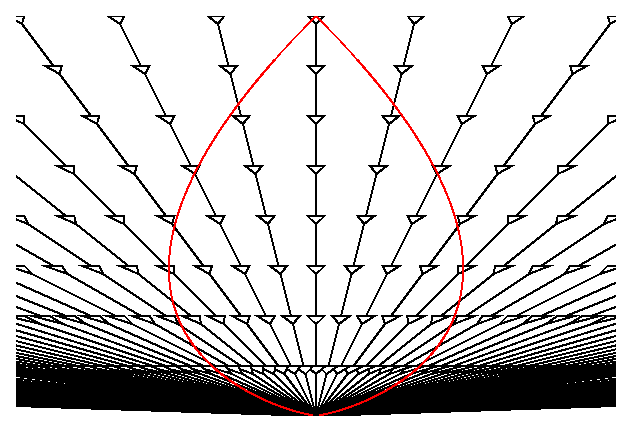
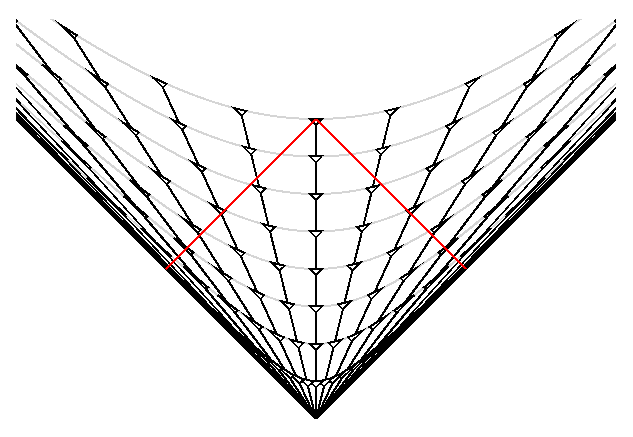
v = HoDnow Dnow = (c/Ho)ln(1+z) 1+z = exp(v/c)Note that the redshift-velocity law is not the special relativistic Doppler shift law
1+z = sqrt[(1+v/c)/(1-v/c)]which only applies to special relativistic coordinates, not to cosmological coordinates.
While the Hubble law distance is in principle measurable, the need for helpers all along the chain of galaxies out to a distant galaxy makes its use quite impractical. Other distances can be defined and measured more easily. One is the angular size distance, defined by
theta = size/DA so DA = size/thetawhere "size" is the transverse extent of an object and "theta" is the angle (in radians) that it subtends on the sky. For the zero density model, the special relativistic x is equal to the angular size distance, x = DA.
Another important distance indicator is the flux received from an object, and this defines the luminosity distance DL through
Flux = Luminosity/(4*pi*DL2)A fourth distance is based on the light travel time: Dltt = c*(to-tem). People who say that the greatest distance we can see is c*to are using this distance. But Dltt = c*(to-tem) is not a very useful distance because it is very hard to determine tem, the age of the Universe at the time of emission of the light we see. And finally, the redshift is a very important distance indicator, since astronomers can measure it easily, while the size or luminosity needed to compute DA or DL are always very hard to determine. The redshift is such a useful distance indicator that it is a shame that science journalists conspire to leave it out of stories: they must be taught the "5 w's but no z" rule in journalism school.
The predicted curve relating one distance indicator to another depends on the cosmological model. The plot of redshift vs distance for Type Ia supernovae shown earlier is really a plot of cz vs DL, since fluxes were used to determine the distances of the supernovae. This data clearly rules out models that do not give a linear cz vs DL relation for small cz. Extension of these observations to more distant supernovae have started to allow us to measure the curvature of the cz vs DL relation, and provide more valuable information about the Universe.
The perfect fit of the CMB to a blackbody allows us to determine the DA vs DL relation. Since the CMB is produced at great distance but still looks like a blackbody, a distant blackbody must look like a blackbody (even though the temperature will change due to the redshift). The luminosity of blackbody is
L = 4*pi*R2*sigma*Tem4where R is the radius, Tem is the temperature of the emitting blackbody, and sigma is the Stephan-Boltzmann constant. If seen at a redshift z, the observed temperature will be
Tobs = Tem/(1+z)and the flux will be
F = theta2*sigma*Tobs4where the angular radius is related to the physical radius by
theta = R/DACombining these equations gives
DL2 = L/(4*pi*F)
= (4*pi*R2*sigma*Tem4)/(4*pi*theta2*sigma*Tobs4)
= DA2*(1+z)4
or
DL = DA*(1+z)2
Models that do not predict this relationship between DA
and DL, such
as the chronometric model or the
tired light model, are ruled out by the
properties of the CMB.
Here is a
Javascript calculator that takes
Ho,
OmegaM,
the normalized
cosmological constant lambda
and the redshift z
and then computes all of the these distances.
Here are the technical formulae
for these distances.
The graphs below show these
distances vs. redshift for three models: the critical density matter
dominated Einstein - de Sitter model (EdS), the empty model, and the
accelerating Lambda CDM model (LCDM) that is the current concensus model.
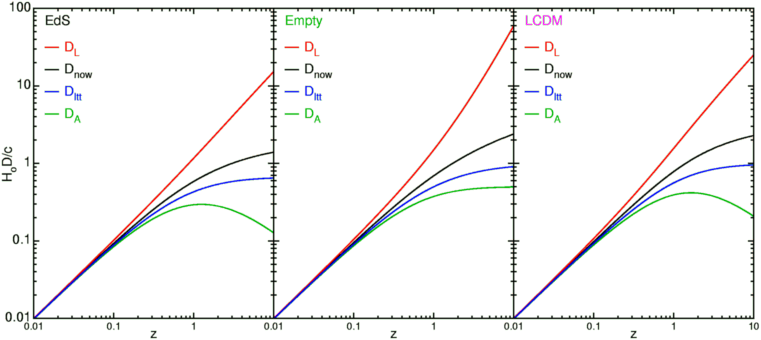
Because the velocity or dDnow/dt is strictly proportional to Dnow, the distance between any pair of comoving objects grows by a factor (1+H*dt) during a time interval dt. This means we can write the distance to any comoving observer as
DG(t) = a(t)*DG(to)where DG(to) is the distance Dnow to galaxy G now, while a(t) is universal scale factor that applies to all comoving objects. From its definition we see that a(to) = 1.
We can compute the dynamics of the Universe by considering an object with distance D(t) = a(t) Do. This distance and the corresponding velocity dD/dt are measured with respect to us at the center of the coordinate system. The gravitational acceleration due to the spherical ball of matter with radius D(t) is g = -G*M/D(t)2 where the mass is M = 4*pi*D(t)3*rho(t)/3. Rho(t) is the density of matter which depends only on the time since the Universe is homogeneous. The mass contained within D(t) is independent of the time since the interior matter has slower expansion velocity while the exterior matter has higher expansion velocity and thus stays outside. The gravitational effect of the external matter vanishes: the gravitational acceleration inside a spherical shell is zero, and all the matter in the Universe with distance from us greater than D(t) can be represented as union of spherical shells. With a constant mass interior to D(t) producing the acceleration of the edge, the problem reduces to the problem of a body moving radially in the gravitational field of a point mass. If the velocity is less than the escape velocity, the expansion will stop and recollapse. If the velocity equals the escape velocity we have the critical case. This gives
v = H*D = v(esc) = sqrt(2*G*M/D)
H2*D2 = 2*(4*pi/3)*rho*D2 or
rho(crit) = 3*H2/(8*pi*G)
For rho less than or equal to the
critical density rho(crit),
the Universe expands forever,
while for rho greater than rho(crit), the Universe will eventually
stop expanding and recollapse. The value of rho(crit) for
Ho = 65 km/sec/Mpc is 8E-30 = 8*10-30 gm/cc
or 5 protons per cubic meter
or 1.2E11 = 1.2*1011 solar masses per cubic
Megaparsec. The latter can be
compared to the observed
1.75E8 = 1.75*108
solar luminosities per Mpc3, requiring a mass-to-light ratio
of 700 in solar units to close the Universe.
If the density is anywhere close to critical most of the matter
must be too dark to be observed.
Current density estimates suggest that
the matter density is between 0.2 to 1 times the critical density, and this
does require that most of the matter in the Universe is dark.
One consequence of general relativity is that the curvature of space
depends on the ratio of
rho to
rho(crit). We call this ratio
Omega = rho/rho(crit). For Omega less than 1, the Universe has
negatively curved or
hyperbolic geometry. For Omega = 1, the Universe has Euclidean
or flat geometry. For Omega greater than 1, the Universe has
positively curved or spherical geometry. We have already seen
that the zero density case has hyperbolic geometry, since the cosmic
time slices in the special relativistic coordinates were hyperboloids
in this model.
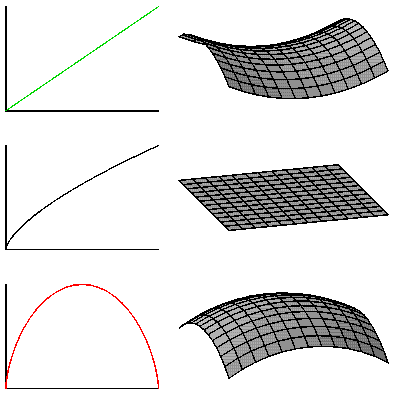
The age of the Universe depends on Omegao as well as Ho. For Omega=1, the critical density case, the scale factor is
a(t) = (t/to)2/3and the age of the Universe is
to = (2/3)/Howhile in the zero density case, Omega=0, and
a(t) = t/to with to = 1/HoIf Omegao is greater than 1 the age of the Universe is even smaller than (2/3)/Ho.
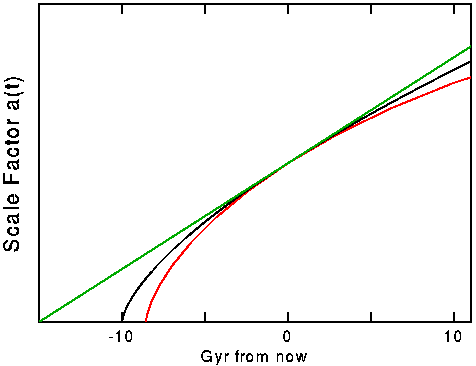
The value of Ho*to is a dimensionless number that should be 1 if the Universe is almost empty and 2/3 if the Universe has the critical density. In 1994 Freedman et al. (Nature, 371, 757) found Ho = 80 +/- 17 and when combined with to = 14.6 +/- 1.7 Gyr, we find that Ho*to = 1.19 +/- 0.29. At face value this favored the empty Universe case, but a 2 standard deviation error in the downward direction would take us to the critical density case. Since both the age of globular clusters used above and the value of Ho depend on the distance scale in the same way, an underlying error in the distance scale could make a large change in Ho*to. In fact, recent data from the HIPPARCOS satellite suggest that the Cepheid distance scale must be increased by 10%, and also that the age of globular clusters must be reduced by 20%. If we take the latest HST value for Ho = 72 +/- 8 (Freedman et al. 2001, ApJ, 553, 47) and the latest globular cluster ages giving to = 13.5 +/- 0.7 Gyr, we find that Ho*to = 0.99 +/- 0.12 which is consistent with an empty Universe, but also consistent with the accelerating Universe that is the current standard model.
However, if Omegao is sufficiently greater than 1,
the Universe will eventually
stop expanding, and then Omega will become infinite. If Omegao is
less than 1, the Universe will expand forever and the density goes
down faster than the critical density so Omega gets smaller and smaller.
Thus Omega = 1 is an unstable stationary point unless the expansion of the
universe is accelerating, and it is quite
remarkable that Omega is anywhere close to 1 now.
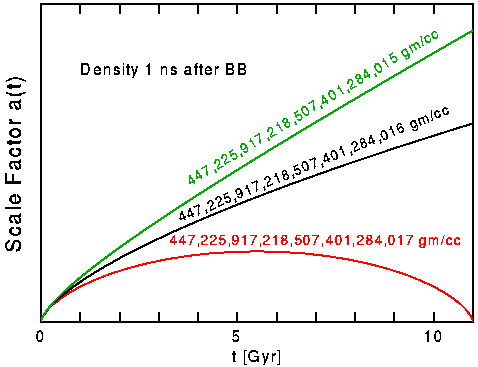
The critical density model is shown in the space-time diagram below.
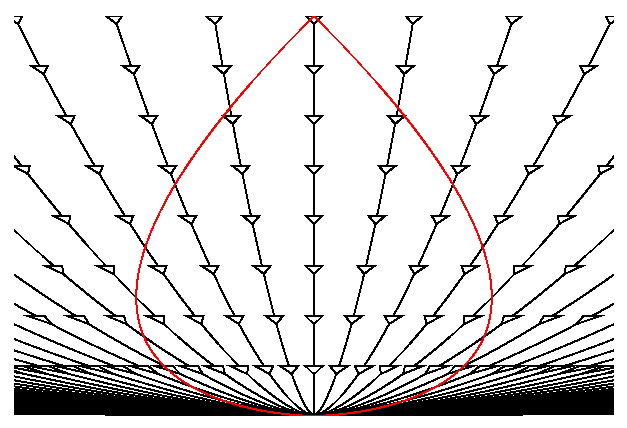
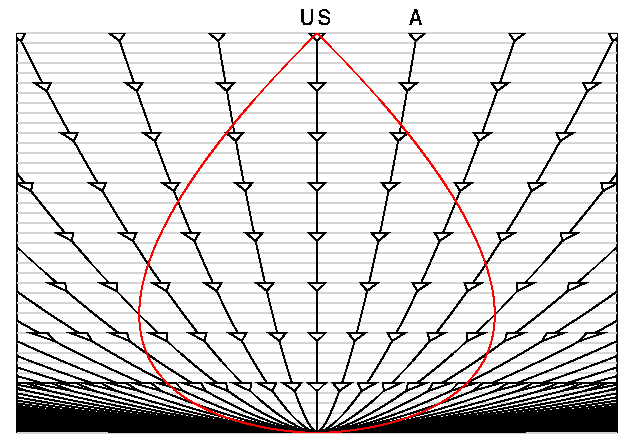
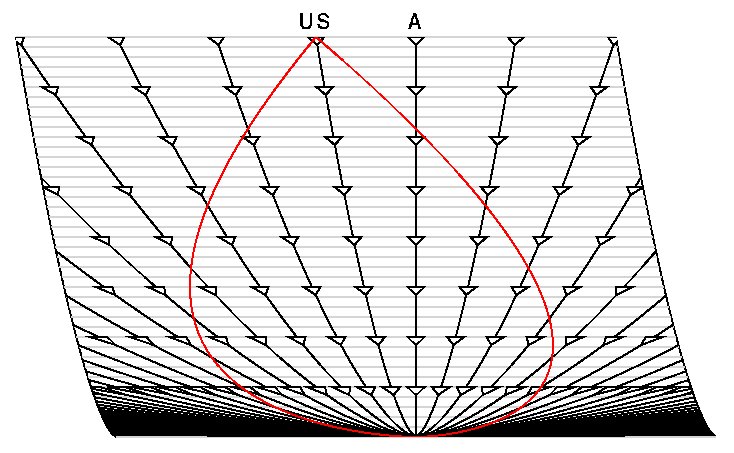
Sometimes it is convenient to "divide out" the expansion of the
Universe, and the space-time diagram shows the result of dividing the
spatial coordinate by a(t). Now the worldlines of galaxies are all
vertical lines.
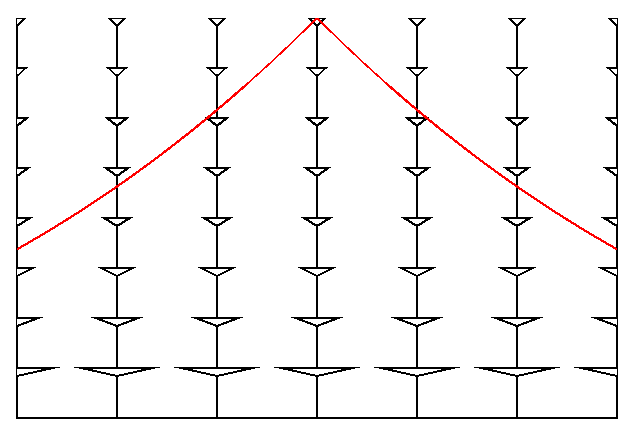

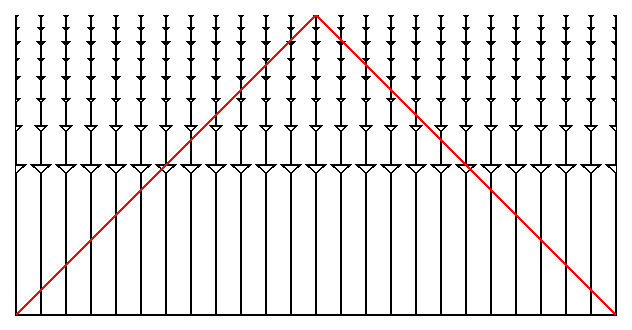
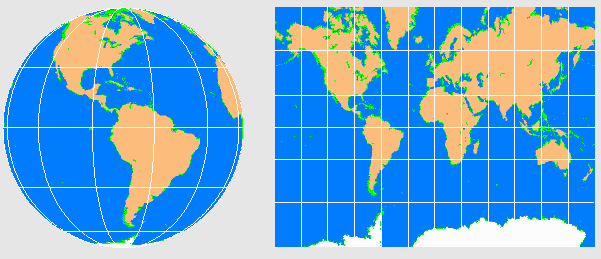
Also remember that the Omegao = 1 spacetime is infinite in extent
so the conformal space-time diagram can go on far beyond our past
lightcone,

Other coordinates can be used as well. Plotting the spatial coordinate
as angle on polar graph paper makes the translation to a different
point-of-view easy. On the diagram below,
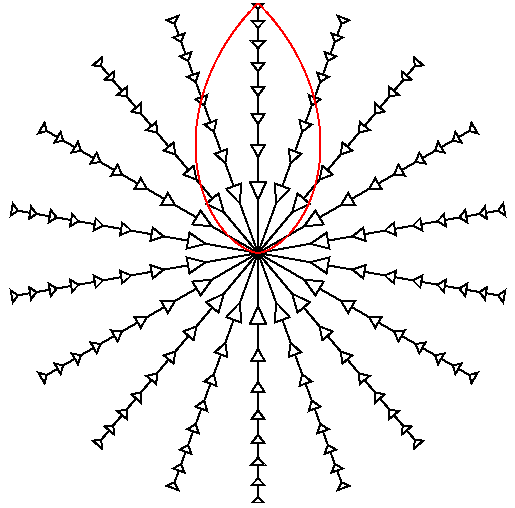
The conformal space-time diagram is a good tool use for describing the
meaning of CMB anisotropy observations. The Universe was opaque before
protons and electrons combined to form hydrogen atoms when the
temperature fell to about 3,000 K at a redshift of 1+z = 1090. After
this time the photons of the CMB have traveled freely through the
transparent Universe we see today. Thus the temperature of the CMB at a
given spot on the sky had to be determined by the time the hydrogen
atoms formed, usually called "recombination" even though it was the
first time so "combination" would be a better name.
Since the wavelengths in the CMB scale the same way that intergalaxy
distances do during the expansion of the Universe, we know that
a(t) had to be 0.0009 at recombination.
For the Omegao = 1 model this implies that
t/to = 0.00003 so for to about 14 Gyr the time is about
380,000 years after the Big Bang. This is such a small fraction of the
current age that the "stretching" of the time axis when making a
conformal space-time diagram is very useful to magnify this part of the
history of the Universe.
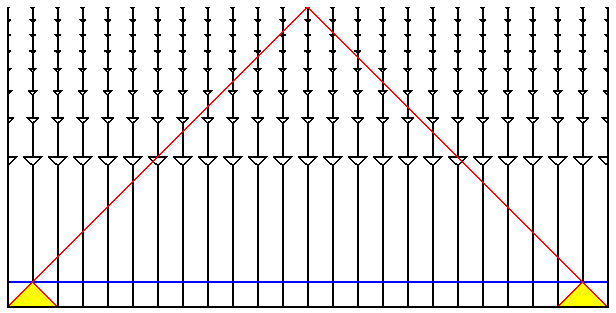
The "inflationary scenario", developed by Starobinsky and by Guth,
offers a solution to the flatness-oldness problem and the
horizon problem. The
inflationary scenario invokes a
vacuum
energy density. We normally think of the vacuum as empty and
massless, and we can determine that the density of the vacuum is
less than 1E-30 gm/cc now. But in quantum field theory, the vacuum
is not empty, but rather filled with virtual particles:

The inflationary scenario proposes that the vacuum energy was
very large during a brief period early in the history of the
Universe. When the Universe is dominated by a vacuum energy
density the scale factor grows exponentially,
a(t) = exp(H(to-t)). The Hubble constant really is constant
during this epoch so it doesn't need the "naught".
If the inflationary epoch lasts long enough the exponential
function gets very large. This makes a(t) very large,
and thus makes the radius of curvature of the Universe
very large. The diagram below shows our
horizon superimposed
on a very large radius sphere on top, or a smaller sphere on
the bottom. Since we can only see as far as our horizon,
for the inflationary case on top the large radius sphere
looks almost flat to us.
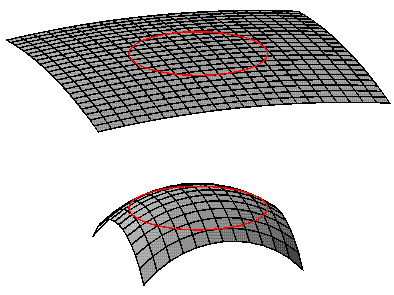
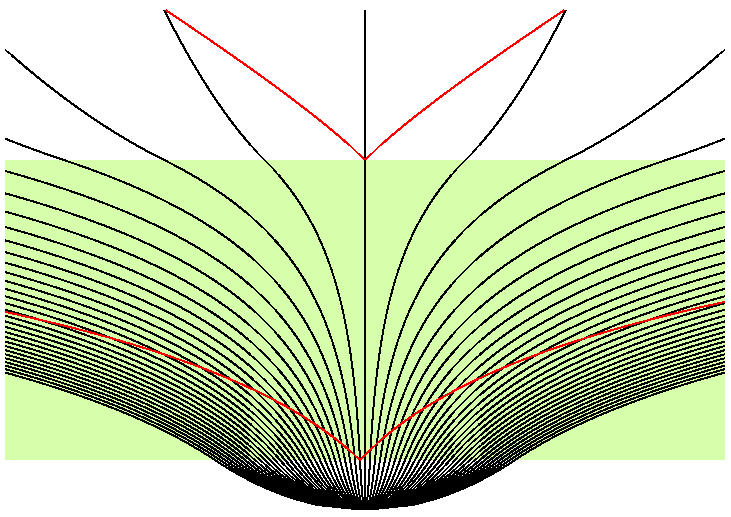
Of course the Universe is not really homogeneous, since it contains
dense regions like galaxies and people. These dense regions should
affect the temperature of the microwave background.
Sachs and Wolfe (1967, ApJ, 147, 73) derived the effect of the
gravitational potential perturbations on the CMB. The
gravitational potential,
phi = -GM/r, will be negative in dense lumps, and positive in
less dense regions. Photons lose energy when they climb out of
the gravitational potential wells of the lumps:

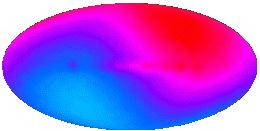
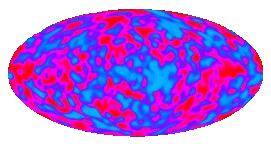
Inflation predicts a certain statistical pattern in the anisotropy.
The quantum fluctuations normally affect very small regions of space,
but the huge exponential expansion during the inflationary epoch
makes these tiny regions observable.
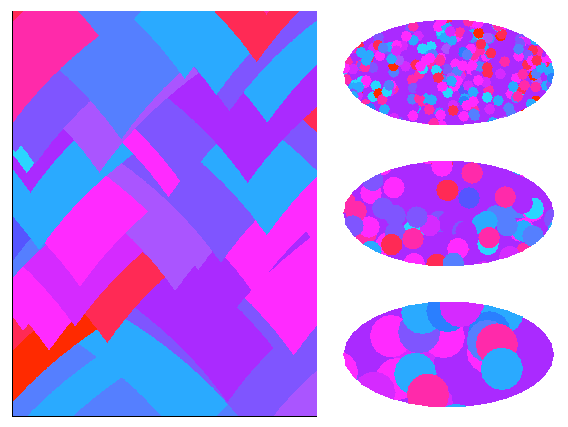
An animated GIF file showing the spatial part of the above space-time diagram
as a function of time is available
here [1.2 MB].

Having found that the observed pattern of anisotropy is consistent
with inflation, we can also ask whether the amplitude implies
gravitational forces large enough to produce the observed clustering
of galaxies.
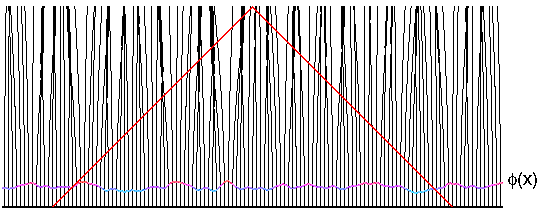
COBE was not able to see spots as small as clusters or even superclusters of galaxies, but if we use "equal power on all scales" to extrapolate the COBE data to smaller scales, we find that the gravitational forces are large enough to produce the observed clustering, but only if these forces are not opposed by other forces. If the all the matter in the Universe is made out of the ordinary chemical elements, then there was a very effective opposing force before recombination, because the free electrons which are now bound into atoms were very effective at scattering the photons of the cosmic background. We can therefore conclude that most of the matter in the Universe is "dark matter" that does not emit, absorb or scatter light. Furthermore, observations of distant supernovae have shown that most of the energy density of the Universe is a vacuum energy density (a "dark energy") like Einstein's cosmological constant that causes an accelerating expansion of the Universe. These strange conclusions have been greatly strengthened by temperature anisotropy data at smaller angular scales which was be provided by the Wilkinson Microwave Anisotropy Probe (WMAP) in 2003.
FAQ | Tutorial : Part 1 | Part 2 | Part 3 | Part 4 | Age | Distances | Bibliography | Relativity
© 1996-2017 Edward L. Wright. Last modified 21 Jul 2017